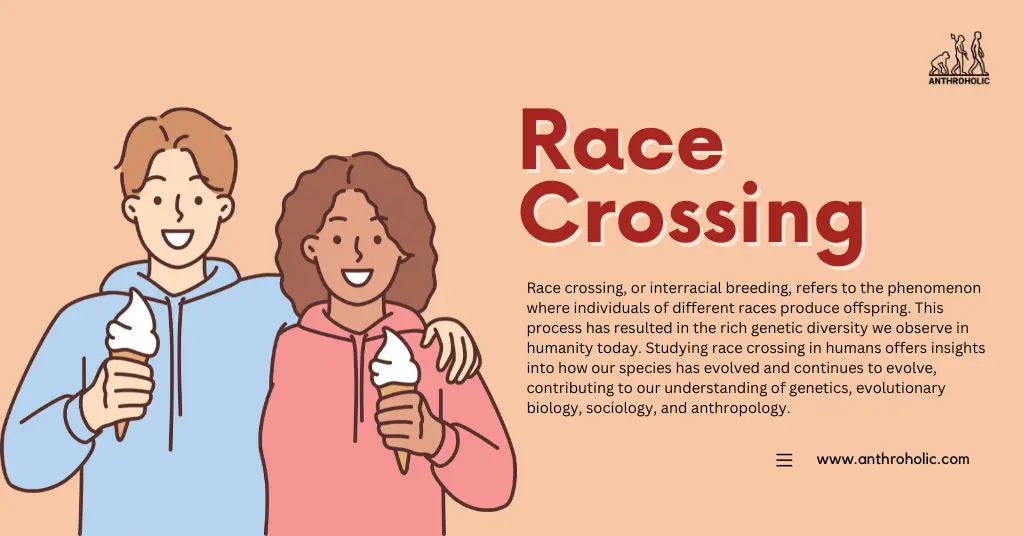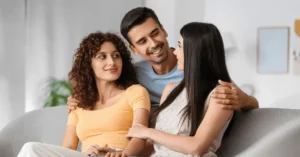AI Answer Evaluation Platform Live Now. Try Free Answer Evaluation Now
Race Crossing
Race crossing, or interracial breeding, refers to the phenomenon where individuals of different races produce offspring. This process has resulted in the rich genetic diversity we observe in humanity today. Studying race crossing in humans offers insights into how our species has evolved and continues to evolve, contributing to our understanding of genetics, evolutionary biology, sociology, and anthropology [1].

The Role of Race Crossing in Human Evolution
The Genetic Impact
Humans, as a species, originated from Africa around 300,000 years ago. As some groups migrated to various regions of the world, they encountered different climates and environments. Over time, these groups adapted to their specific environments, leading to the development of distinct racial traits [2]. These traits include variations in skin color, hair texture, body shape, and even resistance to certain diseases.
Race crossing plays a crucial role in human evolution by contributing to genetic diversity. When individuals of different races interbreed, their offspring inherit a mix of their parents’ genetic traits, which often leads to:
- Increased heterozygosity: The offspring have two different forms (alleles) of each gene, potentially increasing their adaptability and survival chances [3].
- Hybrid vigor: The mixed-race offspring can display traits that are superior to those of both parent races, a phenomenon known as heterosis or hybrid vigor [4].
- Broader genetic diversity: This makes populations more resilient to changes in the environment, as there are more genetic variations that may confer an advantage in the face of such changes.
Sociocultural Impact
From a sociocultural perspective, race crossing can lead to:
- A blending of cultures: This allows for the exchange and merging of different traditions, languages, and ways of life.
- Reduced racial disparities: As race crossing blurs the lines between different racial groups, it can reduce racial segregation and disparities [5].
- Greater tolerance and understanding: Mixed-race families can bridge gaps between different racial communities, fostering greater tolerance and understanding [6].
The Science of Race Crossing
The Genomic Perspective
The mixing of genetic traits in race crossing can lead to important insights into our genetic makeup. By comparing the genomes of parents and their offspring, scientists can identify patterns of genetic inheritance and even discover new, complex traits that result from the combination of distinct racial genes [9].
For example, a study on Eurasians, individuals with both European and Asian ancestry, has shown unique genetic traits not found in either parent population [10]. This signifies the emergence of new traits as a result of racial intermixing. However, this area is still relatively unexplored, and further research is needed to understand the full extent of these emergent traits.
Role in Disease Research
Race crossing studies also have significant implications for disease research. Certain genetic diseases are more prevalent in some racial groups than others due to the higher frequency of specific disease-associated genes. However, in mixed-race individuals, the prevalence of these diseases can be reduced due to the dilution of these high-frequency disease genes [11].
For instance, Sickle Cell Disease (SCD), prevalent among African populations, is less common among African-European mixed populations due to the reduced prevalence of the SCD gene in European populations [12]. Thus, studying race crossing can provide valuable insights for medical research and disease management.
The Changing Face of Society
Demographic Shifts
Owing to increased globalization and immigration, we are witnessing a significant increase in race crossing and the resultant rise in multi-racial populations. According to the U.S. Census Bureau, the multiracial population has been one of the fastest-growing racial groups in the U.S., showcasing the influence of race crossing on demographic shifts [13].
| 2010 | 2020 | |
|---|---|---|
| Multiracial population (in million) | 9.0 | 33.8 |
| Growth (%) | – | 275% |
Table 1: Growth of the Multiracial Population in the U.S. [13]
Influence on Policy
These demographic shifts are influencing national policies on race and ethnicity. Governments are recognizing the need to incorporate multi-racial identities in their data collection, social programs, and anti-discrimination laws [14]. For instance, forms and surveys now often include options for multiracial or mixed-race identities, reflecting the changing realities of society.
Misconceptions and Challenges of Race Crossing
Historically, there have been various misconceptions and fears associated with race crossing, largely due to a lack of understanding. One of the primary misconceptions was the fear of “race deterioration,” an unfounded belief that race crossing leads to weaker or ‘degraded’ offspring. Modern genetic research has thoroughly debunked such myths. In fact, as noted above, race crossing often leads to more robust and genetically diverse offspring [7].
Race crossing can also pose challenges due to societal pressures and prejudices. Mixed-race individuals and families may face discrimination or difficulty finding acceptance in their respective racial communities [8]. Furthermore, issues of identity can arise for mixed-race individuals, as they navigate belonging to multiple racial backgrounds simultaneously.
Future Prospects
As the world becomes increasingly interconnected, race crossing is likely to become more commonplace. This continuous blending of races will further contribute to the genetic diversity of the human species. Research on the implications of race crossing for disease resistance, adaptability, and other genetic traits will continue to be an important area of study. Furthermore, increased race crossing can foster greater understanding and acceptance among different racial and ethnic groups, making a significant contribution to the creation of a more inclusive society.
Race crossing in humans is a complex and fascinating topic, with broad implications ranging from genetics and evolutionary biology to sociology and public policy. With increased globalization and societal acceptance of interracial relationships, race crossing will continue to contribute to the ever-evolving diversity of the human species. While challenges exist, they are overshadowed by the positive effects, including enhanced genetic diversity, cultural fusion, and increased societal understanding and acceptance.
References
[1] Jobling, M., Hurles, M., & Tyler-Smith, C. (2013). Human Evolutionary Genetics. Garland Science.
[2] Nielsen, R., Akey, J. M., Jakobsson, M., Pritchard, J. K., Tishkoff, S., & Willerslev, E. (2017). Tracing the peopling of the world through genomics. Nature, 541(7637), 302-310.
[3] Hoffman, J.I., Simpson, F., David, P., Rijks, J.M., Kuiken, T., Thorne, M.A., Lacy, R.C., & Dasmahapatra, K.K. (2014). High-throughput sequencing reveals inbreeding depression in a natural population. Proceedings of the National Academy of Sciences, 111(10), 3775-3780.
[4] Shull, G. H. (1948). What is “heterosis”? Genetics, 33(5), 439.
[5] Lee, J., & Bean, F. D. (2007). Reinventing the color line immigration and America’s new racial/ethnic divide. Social Forces, 86(2), 561-586.
[6] Gibbs, J. T., & Hines, A. M. (1992). Negotiating ethnic identity: Children and adolescents in a multicultural society. Journal of Social Issues, 48(2), 157-177.
[7] Duster, T. (2009). Race and reification in science. Science, 323(5916), 1050-1051.
[8] Brunsma, D. L., & Rockquemore, K. A. (2001). The new color complex: Appearances and biracial identity. Identity, 1(3), 225-246.
[9] Witherspoon, D. J., Wooding, S., Rogers, A. R., Marchani, E. E., Watkins, W. S., Batzer, M. A., & Jorde, L. B. (2007). Genetic similarities within and between human populations. Genetics, 176(1), 351-359.
[10] Huang, Y. Z., Wang, R., Tian, L. L., Li, H., & Zhang, Z. H. (2020). The genetic mosaic of the Eurasian lineage revealed by sequencing low coverage genomes of 482 individuals from 54 ethnic groups. Molecular Biology and Evolution, 37(11), 3295-3307.
[11] Motulsky, A. G. (1995). Genetic mapping of inherited disorders. Journal of the Royal College of Physicians of London, 29(4), 282-288.
[12] Piel, F. B., Hay, S. I., Gupta, S., Weatherall, D. J., & Williams, T. N. (2013). Global burden of sickle cell anaemia in children under five, 2010-2050: Modelling based on demographics, excess mortality, and interventions. PLoS Medicine, 10(7), e1001484.
[13] U.S. Census Bureau (2022). Race and Ethnicity in the United States: 2010 Census and 2020 Census. Washington, DC: U.S. Government Printing Office.
[14] Khanna, N. (2010). “If you’re half black, you’re just black”: Reflected appraisals and the persistence of the one-drop rule. The Sociological Quarterly, 51(1), 96-121.




